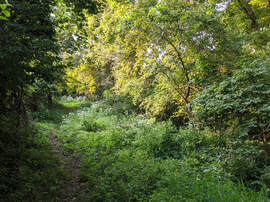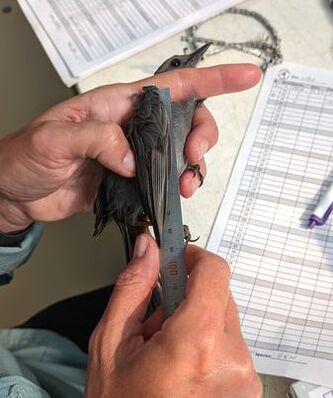|
Like BSBO on Facebook or follow on Instagram for daily updates and photos from our Navarre Marsh banding station during spring and fall migration.
Visit the BSBO Bird Bander's Blog for more detailed information and insights during the banding season. |
Navarre Marsh Banding Station
|
BSBO has been conducting standardized spring and fall migration monitoring efforts at its Navarre Marsh Banding Station since 1989. This long-term study has gathered data on over 400,000 individual birds of 150 species and has supported several affiliated projects through supplemental data collection during monitoring efforts.
The banding station is located in the Navarre Marsh unit of Ottawa National Wildlife Refuge on the southwest shore of Lake Erie, behind the Davis-Besse Nuclear Power Station in Oak Harbor, Ohio. This extensive marsh complex consists of open-water marsh units, cattail marsh, and upland areas in varying degrees of succession. The station is comprised of Carolinian forest (Eastern Cottonwood, Hackberry, Black Locust, Kentucky Coffeetree), dogwood and honeysuckle understory, and buttonbush marsh. Three layers of data are collected at the station, with this protocol from Navarre being used as the model for the Midwest Migration Network. Each operating day, migration is documented through three standardized methods:
Operating Protocol:
Once at the station, all birds are identified to species or subspecies and banded with an aluminum band stamped with a unique nine-digit serial number. After being banded, birds are aged, sexed, wing length measured, weighed, and visually inspected for fat deposits and breast muscle condition. Recaptured birds undergo the same data collection process, only receiving a new band if their original band is in need of replacement. A project of this magnitude would not be possible without the dedication of numerous volunteers throughout each banding season and donors who support the resources needed to operate this station. All banding, marking, and sampling is being conducted under a federally authorized Bird Banding Permit issued by the U.S. Geological Survey’s BBL. |
Significance of the Region

By volume, BSBO's Navarre Marsh Banding Station is one of the largest songbird banding operations on the continent. While the number of birds banded annually at the station presents the opportunity for a significant amount of data to be collected, it also demonstrates the immense volume of birds using the lakeshore of Lake Erie.
The beach ridge habitat found in Navarre is one of the largest remaining of this kind of plant community near the lakeshore. Along with neighboring state and federal areas, these beach ridges act as safe havens for migrating birds in both spring and fall, providing areas to rest and refuel before continuing their journeys. Lake Erie itself acts as a barrier to birds, forcing them down and concentrating them into these available habitats. With a landscape largely segmented by agriculture and development, the beach ridges and marshes near Lake Erie host millions of birds during their annual passage. Based (in-part) on BSBO's long-term dataset from Navarre, the Lake Erie Western Basin has been designated as a Globally Important Bird Area by the National Audubon Society.
Learn more about the timing of migration through the region:
Timing of Spring Migration
Timing of Fall Migration
Timing of Fall Shorebird Migration
Spring Migration Wave Theory
The beach ridge habitat found in Navarre is one of the largest remaining of this kind of plant community near the lakeshore. Along with neighboring state and federal areas, these beach ridges act as safe havens for migrating birds in both spring and fall, providing areas to rest and refuel before continuing their journeys. Lake Erie itself acts as a barrier to birds, forcing them down and concentrating them into these available habitats. With a landscape largely segmented by agriculture and development, the beach ridges and marshes near Lake Erie host millions of birds during their annual passage. Based (in-part) on BSBO's long-term dataset from Navarre, the Lake Erie Western Basin has been designated as a Globally Important Bird Area by the National Audubon Society.
Learn more about the timing of migration through the region:
Timing of Spring Migration
Timing of Fall Migration
Timing of Fall Shorebird Migration
Spring Migration Wave Theory
Monitoring Objectives
|
Data from this project has been used to develop the Lake Erie Management Plan and the Beneficial Wildlife Impairments section of the Clean Water Act, and has been widely used for local and regional management plans. From this long-term dataset, BSBO has been able to develop the "Wave Theory" of spring songbird migration, detailing the arrival and peak time of many species, by sex and age.
Ongoing monitoring objectives include:
|
Collaboration
|
On average, BSBO bands 6,000 passerine and near-passerines in the spring and 5,000 in the fall of 100 species, with nearly 1,000 recaptures and 150 returns each season. If you're interested in collaborating on a project or collecting data with us during the migration season, please fill out this form of interest.
BSBO's Navarre Marsh Banding Station resources:
|






